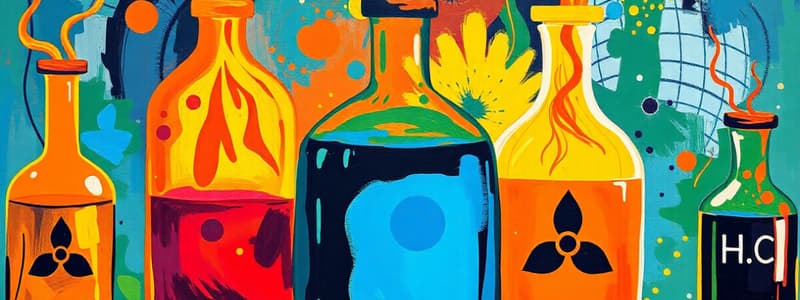Podcast
Questions and Answers
Which of the following is an example of a toxic chemical?
Which of the following is an example of a toxic chemical?
- Sulfuric acid
- Sodium metal
- Gasoline
- Cyanide (correct)
What is the primary effect of corrosive chemicals?
What is the primary effect of corrosive chemicals?
- Causing genetic mutations
- Harming fetal development
- Damaging skin and tissues (correct)
- Causing cancer
Which type of chemical hazard easily catches fire?
Which type of chemical hazard easily catches fire?
- Flammable chemicals (correct)
- Toxic chemicals
- Corrosive chemicals
- Reactive chemicals
What is a characteristic of explosive chemicals?
What is a characteristic of explosive chemicals?
Which chemicals react violently with air, water, or other chemicals?
Which chemicals react violently with air, water, or other chemicals?
What is the primary effect of carcinogens?
What is the primary effect of carcinogens?
Which type of chemical hazard causes genetic mutations?
Which type of chemical hazard causes genetic mutations?
What is the primary effect of teratogens?
What is the primary effect of teratogens?
Which route of chemical exposure involves breathing fumes, dust, or gases?
Which route of chemical exposure involves breathing fumes, dust, or gases?
How can chemicals enter the body through skin absorption?
How can chemicals enter the body through skin absorption?
What does 'ingestion' refer to as a route of chemical exposure?
What does 'ingestion' refer to as a route of chemical exposure?
Through what means does injection allow chemicals to enter the body?
Through what means does injection allow chemicals to enter the body?
What are acute effects of chemical hazards?
What are acute effects of chemical hazards?
What are the long-term effects of chemical exposure called?
What are the long-term effects of chemical exposure called?
What does substitution refer to in the context of chemical hazard control?
What does substitution refer to in the context of chemical hazard control?
What is the purpose of engineering controls in managing chemical hazards?
What is the purpose of engineering controls in managing chemical hazards?
What do administrative controls in chemical safety primarily focus on?
What do administrative controls in chemical safety primarily focus on?
What is an example of Personal Protective Equipment (PPE)?
What is an example of Personal Protective Equipment (PPE)?
Why are spill kits important in chemical safety?
Why are spill kits important in chemical safety?
What does first aid involve in the event of chemical exposure?
What does first aid involve in the event of chemical exposure?
Flashcards
Chemical hazards
Chemical hazards
Substances that can harm humans, animals, or the environment due to their toxic, corrosive, flammable, explosive, or reactive properties.
Toxic Chemicals
Toxic Chemicals
Cause poisoning upon exposure.
Corrosive Chemicals
Corrosive Chemicals
Damage skin and tissues on contact.
Flammable Chemicals
Flammable Chemicals
Signup and view all the flashcards
Explosive Chemicals
Explosive Chemicals
Signup and view all the flashcards
Reactive Chemicals
Reactive Chemicals
Signup and view all the flashcards
Carcinogens
Carcinogens
Signup and view all the flashcards
Mutagens
Mutagens
Signup and view all the flashcards
Teratogens
Teratogens
Signup and view all the flashcards
Inhalation
Inhalation
Signup and view all the flashcards
Skin Absorption
Skin Absorption
Signup and view all the flashcards
Ingestion
Ingestion
Signup and view all the flashcards
Injection
Injection
Signup and view all the flashcards
Acute Effects
Acute Effects
Signup and view all the flashcards
Chronic Effects
Chronic Effects
Signup and view all the flashcards
Substitution
Substitution
Signup and view all the flashcards
Engineering Controls
Engineering Controls
Signup and view all the flashcards
Administrative Controls
Administrative Controls
Signup and view all the flashcards
Personal Protective Equipment (PPE)
Personal Protective Equipment (PPE)
Signup and view all the flashcards
Spill Kits
Spill Kits
Signup and view all the flashcards
Study Notes
- Chemical hazards are substances that can harm humans, animals, or the environment
- Hazards have toxic, corrosive, flammable, explosive, or reactive properties, found in laboratories, industries, agriculture, and households.
Types of Chemical Hazards
- Toxic Chemicals cause poisoning; examples include cyanide, mercury, and lead
- Corrosive Chemicals damage skin and tissues; examples include sulfuric acid and sodium hydroxide
- Flammable Chemicals easily catch fire; examples include gasoline and ethanol
- Explosive Chemicals can detonate under certain conditions; examples include TNT and nitroglycerin
- Reactive Chemicals react violently with air, water, or other chemicals; examples include sodium metal and peroxides
- Carcinogens cause cancer; examples include benzene and asbestos
- Mutagens cause genetic mutations; an example is formaldehyde
- Teratogens harm fetal development; an example is thalidomide
Routes of Chemical Exposure
- Inhalation involves breathing fumes, dust, and gases
- Skin Absorption involves contact with liquids or powders
- Ingestion involves swallowing contaminated food/drinks
- Injection involves needle sticks or cuts with contaminated objects
Effects of Chemical Hazards
- Acute Effects cause immediate harm, such as burns, poisoning, and respiratory distress
- Chronic Effects are from long-term exposure leading to diseases, such as cancer and organ damage
Control Measures for Chemical Hazards
- Substitution replaces hazardous chemicals with safer alternatives
- Engineering Controls use fume hoods, ventilation, and closed systems
- Administrative Controls include proper training, labeling, and restricted access
- Personal Protective Equipment (PPE) includes gloves, goggles, lab coats, and respirators
Emergency Response
- Spill Kits are for safe cleanup of chemical spills
- First Aid involves immediate washing and antidotes if available
- Emergency Showers & Eye Wash Stations must be accessible
Safe Storage & Handling
- Store chemicals based on compatibility, such as acids away from bases
- Use proper containers, like metal cabinets for flammable liquids
- Follow Safety Data Sheets (SDS) for handling instructions
Studying That Suits You
Use AI to generate personalized quizzes and flashcards to suit your learning preferences.




